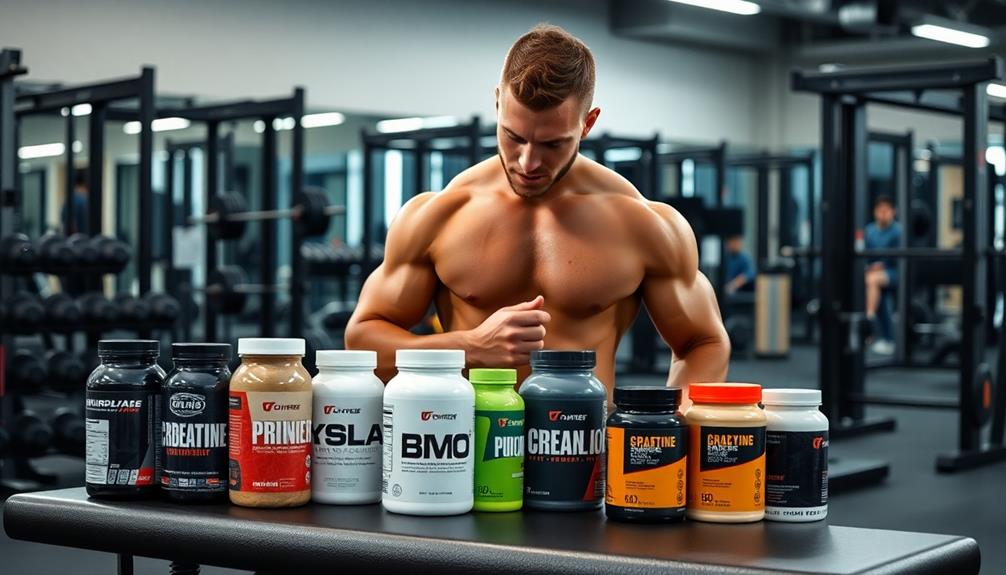To build massive muscle, you'll need to optimize your workout routine, master progressive overload, and fuel your gains with proper nutrition. Focus on compound exercises, lift weights 3-4 times per week, and gradually increase your weights or reps. Consume 1.6 to 2.2 grams of protein per kilogram of body weight, along with extra calories for growth. Perfect your form to maximize muscle engagement and prevent injuries. Prioritize rest and recovery, aiming for 7-9 hours of sleep nightly. Don't forget to track your progress and adjust your plan as needed. By following these steps, you'll be well on your way to achieving your muscle-building goals. Discover more detailed strategies to accelerate your gains.
Core Insight
- Focus on compound exercises like squats, deadlifts, and bench presses to target multiple muscle groups simultaneously.
- Implement progressive overload by gradually increasing weight, reps, or sets in your workouts.
- Consume adequate protein (1.6-2.2g per kg body weight) and a caloric surplus of 300-500 calories daily.
- Perfect your form on each exercise, prioritizing quality over quantity for optimal muscle growth.
- Prioritize rest and recovery, including 7-9 hours of sleep and 48-hour breaks between working the same muscles.
Optimize Your Workout Routine

To build serious muscle, you need to optimize your workout routine. Focus on compound exercises like squats, deadlifts, and bench presses. These moves work multiple muscle groups at once, stimulating more muscle fibers and promoting overall growth. Adding lean protein powders to your diet can also support muscle growth and recovery, especially after your workout.
Try to lift weights 3-4 times per week, giving yourself enough rest between sessions. Use progressive overload, which means gradually increasing the weight, reps, or sets over time. This challenges your muscles, forcing them to adapt and grow.
Mix heavy lifting (3-5 reps) with moderate rep ranges (8-12 reps) to target different muscle fibers. Don't skip isolation exercises to work on specific muscle groups and maintain balance.
Master Progressive Overload

Progressive overload is key for building muscle and strength. It means slowly increasing your weights, number of sets, or reps in your workouts. To do it right, keep a detailed log of your training. Each week, try to lift a bit more than the last time. Supplements can help you recover and build muscle, but they work best when combined with a good workout plan.
Don't expect to make progress every session. If you can't increase the weights, you can still improve by using better form, resting less between sets, or keeping your muscles working longer on each rep. Stay patient and stick with it.
Pay attention to your body's signals. If you feel burned out or have pain that won't go away, take a break to recover before training hard again.
Fuel Your Gains

Building muscle requires more than just training hard in the gym. Eating right is equally important for fueling your gains and helping you bulk up.
To grow, your body needs extra calories and protein. Aim to eat about 300-500 calories above what you normally would each day. You'll also want to get plenty of protein, around 1.6 to 2.2 grams for every kilogram you weigh.
Don't fear carbs – they give you energy to power through workouts and recover afterwards. Go for nutritious options like whole grains, sweet potatoes, and oats. Quick-digesting carb supplements can speed up recovery after training. Healthy fats from foods like avocados, nuts, and olive oil are important too, as they help your body produce muscle-building hormones.
Round out your diet with fruits and veggies to get vitamins and minerals that support your health and gains. And of course, drink lots of water to stay hydrated. Your muscles need it!
Follow these nutrition tips consistently and you'll be well on your way to building the strong, muscular physique you're after. Fuel wisely and train hard – that's the winning combination.
Perfect Your Form

Proper form is key for building muscle and avoiding injuries. When you exercise, focus on keeping your body in the right position for each move. Start with lighter weights to nail your technique before going heavier. Using things like infrared heat pads can help with sore muscles and speed up recovery between workouts.
For big lifts like squats and deadlifts, keep your core tight and your spine straight. Chest up, shoulders back. For upper body work, control the weight in both directions. Don't swing or use momentum.
Take your time with each rep. Don't rush. Slow, controlled reps work your muscles better. If you're not sure about your form, think about hiring a trainer or using mirrors to check yourself. Focus on quality over quantity for the best muscle gains.
Prioritize Rest and Recovery

Rest is key for building muscle and getting fitter. Your muscles need time to heal and get stronger after tough workouts. Make sure to get 7-9 hours of sleep each night. This helps your muscles recover and keeps your hormones in check. Take rest days and wait at least 48 hours before working the same muscles again. Light cardio or stretching on rest days can boost blood flow and ease muscle soreness.
Eating right is also important for recovery. Eat foods high in protein and complex carbs to refuel and repair muscles. Drink lots of water to stay hydrated. If you're feeling really tired or sore, take it easy and lighten up your workouts. Pay attention to what your body is telling you.
Supplement Wisely

Supplements can support your muscle growth, but focus on proven ones. Whey protein helps recovery after workouts. Take 20-30g. Creatine boosts strength – 5g a day is good. BCAAs aid muscle building. Try 5-10g before or during exercise. Always prioritize rest and nutrition first.
Track Your Progress

Keep an eye on your progress as you build muscle. Measure parts of your body, like your chest, arms, and thighs, every 2-4 weeks. Take photos from different angles to see how your body is changing. Using gel packs after workouts can help with soreness and swelling, which might affect your progress.
Write down your exercises, sets, reps, and weights in a workout log. This will help you see how much stronger you're getting and make sure you're challenging your muscles enough. Check your weight each week, but remember that muscle gain doesn't always show up on the scale.
Pay attention to how much energy you have and how long it takes you to recover between workouts. If you feel tired all the time, you may need to change your workouts or eating habits. By keeping track of these things, you can adjust your plan as needed and stay motivated as you see your progress.
Frequently Asked Questions
How Long Does It Take to See Visible Muscle Gains?
You'll typically notice visible muscle gains within 4-8 weeks of consistent training and proper nutrition. However, individual results vary based on factors like genetics, workout intensity, diet, and rest. Keep pushing yourself, and you'll see progress soon.
Can I Build Muscle Without Using Protein Supplements?
Yes, you can build muscle without protein supplements. You'll need to focus on consuming protein-rich whole foods like lean meats, fish, eggs, and legumes. Eat a balanced diet and maintain a caloric surplus while following a consistent strength training program.
Is It Possible to Build Muscle While Losing Fat Simultaneously?
Yes, you can build muscle while losing fat, but it's challenging. You'll need to focus on a high-protein diet, engage in resistance training, and maintain a slight calorie deficit. It's often called "body recomposition" and requires patience and consistency.
How Do Genetics Affect Muscle-Building Potential and Results?
Your genetics play a significant role in muscle-building potential. They influence factors like muscle fiber composition, hormone levels, and body type. While you can't change your genetics, you can optimize your results through tailored training and nutrition.
What's the Ideal Body Fat Percentage for Maximum Muscle Definition?
You'll achieve maximum muscle definition at 6-10% body fat for men and 14-18% for women. However, maintaining these low percentages can be challenging. For sustainable results, aim for slightly higher ranges that you're comfortable maintaining long-term.

